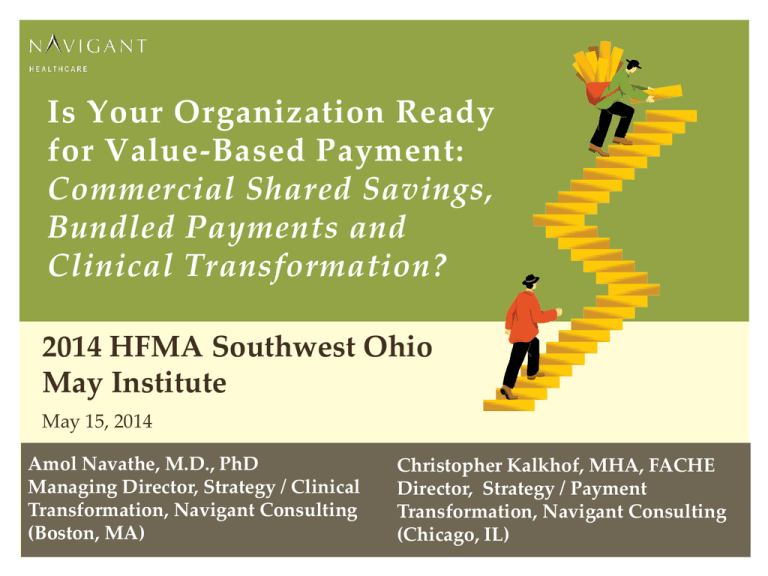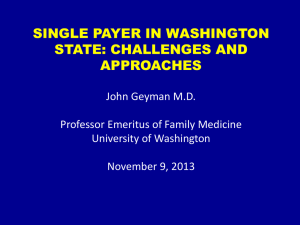Is your Organization Ready for Value-Based Payment?
advertisement

Is Your Organization Ready for Value-Based Payment: Commercial Shared Savings, Bundled Payments and Clinical Transformation? 2014 HFMA Southwest Ohio May Institute May 15, 2014 Amol Navathe, M.D., PhD Managing Director, Strategy / Clinical Transformation, Navigant Consulting (Boston, MA) Christopher Kalkhof, MHA, FACHE Director, Strategy / Payment Transformation, Navigant Consulting (Chicago, IL) TODAY’S PRESENTATION 1. Current and Emerging Risk Sharing/Risk-Based (“RS-RB”) Models: Commercial Shared Savings & Episodic Pricing Models 2. Best Practice Financial/Benchmark Modeling and Impact on FFS 3. Strategic Importance of Parallel Clinical Integration/Clinical Process Change 4. Organization Readiness at the Operational and Clinical Levels 5. Critical Success Factors: Population Health and Care Delivery Models 6. Implementation Roadmap Development: 7. Lessons Learned Page 2 1. CURRENT AND EMERGING RISK SHARING / RISK-BASED (“RS-RB”) MODELS – COMMERCIAL SHARED SAVINGS AND EPISODIC PRICING MODELS Page 3 1. POST-REFORM APPROACHES TO SUSTAINABLE MARGINS: SYSTEMS OF CARE / TRIPLE AIM How will providers and payers operationalize all of this? Future Go-To-Market Systems of Care Payers Administrators Emerging Payments Physicians / Hospitals / Other KEY INITIATIVES Care Coordination Population Health Management Outcomes Data and Payments Consumer Engagement (Finance, PHM & IT etc.) Consumers Aging and Overweight Populations, More Expensive Diseases to Treat, New Payment Models, Physician Shortages & Reduced ESI The payer - provider contracting process has often been characterized as being adversarial vs. collaborative... absent finding a common means to demonstrate measurable value… both parties gamble with their respective futures. Page 4 1. WHAT WILL MY PAYER CONTRACT PORTFOLIO AND PAYMENT MODELS LOOK LIKE IN THE FUTURE? Integrated Care Systems/HEC Risk to Provider Capitation/ Global Comp Member Attribution Shared Risk Population Management Condition/ Episode Bundling PCP Incentives P-4-P Fee-forService Perf. Based Contracts (PBC) PerformanceBased Programs Hospital/Office Source: Navigant Best Practices Capitation + PBC G. Case & Episode Payments Shared Savings COE, Global Case Rates, Episodic Pricing + PBC ACOs TME Shared Savings Narrow Network Products Networks of Care Carve-Out Specialty Services Episodic Prices Graduated/Transitional Risk Strategic Alliances/JVs Collaboration Provider Integration Integrated System Page 5 Page 5 1. REVENUE & EXPENSE MANAGEMENT: EXAMPLE VALUE OF CONTRACT MODELING CAPABILITIES Increasing Clinical Integration and Financial Risk Levels / Complexity Dimension Shared Savings Accountable Care Organization One payment per Defined Episode – Movement Away from Utilization Based Reimbursement Population Based Care that Rewards Integration, Quality, Outcomes and Efficiency Designed to Promote Cost Reduction Cost & Utilization Reduction Value Care Coordination Encouraged Required Required Quality Standards Optional Optional Required Physician Alignment Must Align to Achieve Savings Must Align to Achieve Savings Required Overview Source: Navigant Best Practices Utilization Reductions Shared Between Payer and Provider – Incenting Quality over Quantity Bundled Payment Page 6 1. MAJOR PAYER’S CRITERIA FOR COMMERCIAL BUNDLING PARTNERSHIP The measures are nationally accepted as clinically appropriate so there is wide support for improving performance Real dollars are at stake for improvement For each measure, there is a range of performance targets representing a continuum from good care to outstanding care, so the model rewards performance & improvement Data is made available monthly, enabling the organizations to track progress and take action to manage their patient population The groups/partners have strong support from their leadership to implement new systems and act on the data Dynamic/actionable data and reports made available daily, monthly, quarterly, helping organizations to identify efficiency opportunities at a patient, practice and org. level Page 7 1. COMMERCIAL PAYER CONSIDERATIONS RE: EPISODIC PRICING Current FFS Model E.G., Commercial Payer – FFS Ortho Services Knee, Hip, Spine & Other Ortho $ $ $ $ Acute Care IP Rehab Hosp OP Ctrs IRF / SNF / HH $ Other EP/SS Model Candidate Services: » Oncology, Cardiac, Neuro-Sciences, High Risk Maternity/Neonate; Senior Care Chronic Care & Other Specialist/High Dollar IP Oriented Services » Diffuse collection of interests between physicians and hospitals… non-aligned » Physician primary focus at practice level and/or ambulatory invested interests » Declining economics incents physicians to compete directly with hospitals for higher dollar procedural and diagnostic services » Volume rewarded regardless of quality and outcomes » Pays each provider separately with no linkage to patient care coordination » Payer cost containment through price, payment rules and utilization controls » IT tools, Clinical and Financial Systems designed for traditional FFS business model » Incents providers to focus on services which reimburse the most Page 8 1. COMMERCIAL PAYER EPISODIC PRICING & SHARED SAVINGS: LIMITED DOWNSIDE RISK – RETROSPECTIVE MODEL Page 9 1. COMMERCIAL PAYER EPISODIC PRICING & SHARED SAVINGS: SIGNIFICANT DOWNSIDE RISK - PROSPECTIVE MODEL Page 10 1. COMMERCIAL PAYER EPISODIC PRICING & SHARED SAVINGS: BUILDING THE RATES Page 11 1. COMMERCIAL PAYER EPISODIC PRICING: DEFICIT SHARED SAVINGS RISK SHARING TO CAP Shared Savings Methodology: » Net savings will be shared: › 50% Provider / 50% Payer || 60% Provider / 40% Payer (if meet/exceed quality metrics) » Claims are to be paid by Payer according to each participating provider’s current contracted payment methodology/reimbursements with Payer. › The Provider does not assume any claims payment liability for any Payer par provider. › Provider’s only downside risk is the multiple cap/stop-loss for Episodic budget. › The episodic budgets are inclusive of Payer and member liability credit Provider’s efforts. » Process and audit rights for an annual retrospective reconciliation of actual eligible claims incurred per episodic budget, on an individual patient case basis, across each eligible LOB. › An interim payment during each contract year of surplus sharing... true up at year end. » » » » Net Deficits and eligible surpluses from the prior contract year will be carried forward next. Shared Savings Deficit Downside Cap = 1.5 – 2.0 x the episodic budget per case Shared Savings will be paid In addition to the FFS rate increases. Shared savings deficits do not impact agreed upon FFS rate increases during the contract term. Page 12 1. COMMERCIAL PAYER EPISODIC PRICING: BASELINE BUDGET AND EPISODIC DEFINITION (HIP. KNEE & SPINE) » Baseline calculated from 1-1-13 to 12-31-13 actual total allowed paid claims for all Provider patients covered by eligible commercial LOBs across all Provider physician surgical sites. » Episode Inclusions › Admission/Surgery - Range of MS-DRGs, associated ICD-9 (diagnostic and procedural) and CPT codes for the hospital stay and all covered professional services provided during the admission stay. – Co-morbidity inclusion/exclusion criteria, Length of time and services included postdischarge and Complications Covered › Discharge/Post-Acute Care/Rehab - To agreed upon SNF, IRF and Home Care ICD9, CPT and other Procedural Codes (e.g., RUGs). – Co-morbidity inclusion/exclusion, length of time and complications covered. › Pre-Surgical Testing – Surgical consult, anesthesia consult, surgical team consult, patient and patient/family education, within 1 to 2 calendar days of the surgical procedure date. › Transitional Care Monitoring – During the 90 day post-surgical discharge, patients at a higher risk of readmission will require transitional care monitoring. Page 13 1. COMMERCIAL PAYER EPISODIC PRICING: BASELINE BUDGET AND EPISODIC DEFINITION (HIP. KNEE & SPINE) » Episode Exclusions › All other testing prior to defining diagnosis and determination that surgery was appropriate. › All other testing not in inclusion criteria and PAC services which exceed 90 days window.. » Annual Baseline Budget Adjustments for each eligible episode of care to account for: › Rate increases across its participating providers whom in the aggregate define the baseline. › Payer product adjustments/benefit levels which impact member services utilization. › Case mix/risk adjustment which occurs from member voluntary and involuntary attrition. › Co-morbidity exclusion/inclusion criterion. › A material change in historic Provider Specialist PCP referral relationships. » Shared Savings Payments – Funds Distribution: › Provider will receive the entire shared savings payment from Payer and will be solely responsible for distribution of any shared savings surplus internal to provider partners (FMV). » Quality Metrics for patient quality/improved outcomes and financial incentive awards such as Generally Accepted Ortho Quality Metrics, Patient Satisfaction Measures, HCAHPS Inpatient Facility, Functional Outcome Measures, HOOS, KOOS, VR12 and Other Metrics. » Other - such as care management/care navigation and transitional monitoring fees Page 14 2. BEST PRACTICES FINANCIAL / BENCHMARK MODELING AND IMPACT ON FFS Page 15 2. MODELING IMPACT OF RB-RS ARRANGEMENTS IS CRITICAL TO NEGOTIATING SUCCESS To assess the potential financial impact of value based payment arrangements such as commercial shared savings contracts, determine the margin/revenue impact on FFS revenues as well as potential avoidable costs/utilization with each major payer... financial/analytical models must be built. Margin Levers Modeled Margin Lever Utilization Rate and Mix Volumes E.G., Variables To Be Modeled » Identify high risk patients and reduce avoidable utilization. » Steer patients to appropriate site of care. Share savings potential from Payer » Increase the number of managed lives under contract to drive more PMPM revenues » Spread fixed costs over larger revenue base Unit Cost » Reduce underlying cost structure to improve margin position Payer Payments » Make decisions with fact base on impact of discounts for steerage vs. locking in current payment rates Shared Savings » Retain negotiated % of shared savings » Establish internal savings distribution formula that aligns hospital physician incentives Page 16 2. LEVERS FOR SAVINGS ARE OFTEN NOT OBVIOUS Margin Levers Modeled Largest $$ savings from FFS... Avoidable readmissions, 1 day stays and E/D use Margin Lever Downstream Issues to Manage Utilization Rate and Mix » Where is the avoidable utilization? Where can we shift patients to lower cost care sites/lower cost service mix? » Where should we consider clinical process changes? Volumes » How exactly will we grow lives in partnership with payers? » What, if any, underlying discounts do we need to give to steer/retain volume? Unit Cost » Which Value Imperatives need to be accelerated to get unit costs down? Greatest synergistic opportunities... admin & clinical? Payer Payments » What discount rate, if any, will you give the payer? Pricing strategy by service area/service line? Shared Savings » How do we distribute savings? What metrics, what targets, what weights? Impact if we expand physician network, grown lives? Page 17 2. FINANCIAL BUDGETING & PLANNING FOR RISK CONTRACTS: E.G. BUILDING PMPM BUDGETS BASED ON AVOIDABLE COST ANALYSIS2 Source: Navigant Best Practices Cost and Utilization Reductions Achieved Through Care Coordination and Clinical Process Change PMPM After Cost Reduction Starting PMPM Analysis Illustration: PMPM Savings Opportunities Page 18 3. STRATEGIC IMPORTANCE OF PARALLEL CLINICAL INTEGRATION/CLINICAL PROCESS CHANGE Page 19 3. TWIN PILLARS TO SUCCESS UNDER CURVE 2 PAYMENT MODELS Manage Financial Risk Coordinate and Manage Patient Populations Patient and Physician Engagement Infrastructure / Operational Alignment Clinical Integration / Care Model Redesign Increases Value, Equitable & Sustainable Source: Navigant Best Practices C LINICAL T RANSFORMATION PAYMENT T RANSFORMATION High Efficiency Health Care Page 20 3. OUR PRICING, PRODUCT, CARE DELIVERY MODEL DESIGN LEVERS TO TRANSITION FROM CURVE 1 TO CURVE 2 What Network Partners? Physician, Hospitals & Other What Pricing Strategy? FFS + P4P Shared Savings Episodic Bundling Full Risk Absent Parallel Clinical Integration/Clinical Process Change with Payment Model Change... How Will You Manage Risks? IP/OP Increase vs. Decrease? Source: Navigant Best Practices Y2 Y3 Commercial Group ACOs & Other Medicare Advantage Managed Medicaid What Time Line? Y1 Which Products and Which Payers? Y4 Management of Pricing, Product, Network, Operational, Clinical, Financial, Distribution Channel and Competitive Risks? Page 21 3. COMMON ANALYTICS BASE LINKS CLINICAL AND PAYMENT TRANSFORMATION Prioritizing areas of focus based on payment model and areas of need: Shared Savings Bundles ACO Physician-Hospital relationships (e.g. IPA, self- employed) PAC facility preferred partnerships and associated workflows High-risk patient management Governance model (e.g. dyad leadership) Implant and DME cost benchmarking Demand matching across network Chronic disease management and practice variations Pre-op risk management (e.g. glycemic control) Pharmacy utilization Cross-cutting Quality & Performance Metrics and Variation Analysis Page 22 3. TWO KEY WORKSHOPS GUIDE CLINICAL TRANSFORMATION AND DRIVE CLINICIAN ENGAGEMENT Workshop Type #1: SCAMPs Workshop Type #2: RIEs » Standardized Clinical Assessment and Management Plans (SCAMPs) » Rapid Improvement Events (RIEs) » Utilized to dive into clinical decisions with high impact on outcomes and costs. Key to: » Aimed at improving flow through operational bottlenecks or key process misalignments 1. Evidence-based care customized to treatment patterns 1. Focus on early consideration of “root cause analyses” 2. Physician engagement and buy-in 2. Inter-disciplinary approach to improvement 3. Allow for optimal buy-in and adoption into practice. Page 23 4. ORGANIZATION READINESS PLANNING AND ASSESSMENT PROCESS AT THE OPERATIONAL AND CLINICAL LEVELS Page 24 4. KEY FRAMING QUESTIONS: PREPARING FOR PAYMENT AND CLINICAL TRANSFORMATION CHANGES 1. Longer term, how sustainable is our current FFS payment model? 2. If we move away from our FFS to an early stage value-based payment models -how do we minimize the risk of margin erosion? 3. To optimize our net revenue/payment yield part of the margin equation: a) What employer, geographic and payer LOB’s should we target? b) What steerage/keepage opportunities exist and how do we best avoid cannibalizing our higher payments with the same patients? 4. To optimize the labor/non-labor cost part of the margin equation: a) What types of avoidable costs and utilization need to be removed? b) What types of administrative costs can be reduced? c) Which incentives need to change, if any, to achieve the above? 5. What operational and clinical process changes do we need to make to be successful under value-based payments? 6. What risks do we need to plan for and manage? Page 25 4. WHAT CAPABILITIES DO SYSTEMS NEED TO ADD TO BE SUCCESSFUL UNDER RS-RB PAYMENT MODELS? Capitation/ Global Comp Population Management Member Attribution Change Management Risk to Provider Predictive Modeling Cost of Care Reduction Condition/ Episode Bundling Physician Leadership Clinical & Operating Efficiency Practice Variation Improvement Metrics Analytic Tools P-4-P Hospital/Office Source: Navigant Best Practices Patient Monitoring Quality Improvement Focus Strategic Leadership Integrated Care Systems/HEC Payment Distribution Process Clinical Decision Support Systems Comprehensive Improvement Metrics Focus on Prevention Outcomes Based Metrics Care Coordination Clinical & Financial Reduce Avoidable Integration Costs EBM Reporting / Standardized Organizational Leadership/ Processes Tracking Tools Governance Structure Member Engagement Collaboration Provider Integration Integrated System 4. YOUR OPERATIONAL AND CLINICAL READINESS FOR VALUE BASED PAYMENTS STARTS WITH A RISK ASSESSMENT Summary of Risks – Population Health Management & Risk Based Contracting » Plan for Risks » Invest in Capabilities to Avoid/Mitigate Risks » Timelines are Important » Develop Detailed Implementation Plans & Execute » Manage Risks Across are Continuum » Performance Accountability » Start in… When? » Alignment w/ Strategic Plan » Results to Report Across Formal PMO Process PRODUCTS, PRICING & DISTRIBUTION CHANNEL RISKS PAYER CONTRACTING & VALUE-BASED PAYMENT RISKS EXECUTION RISK EBM / PHM CLINICAL CARE MODEL RISKS FINANCIAL, CAPITAL & BUDGET RISKS CARE CONTINUUM COMPOSITION RISKS COMPETITIVE RISKS UNIFIED ANALYTICS & INFRASTRUCTURE RISKS Page 27 4. READINESS RATINGS: PERFORMING A FINANCE/CONTRACTING/ INFRASTRUCTURE GAP ASSESSMENT Risk-Based Contracting Best Practices Measures Current State Assessment Revenue & Expense Management Financial Budgeting and Planning for Risk Contracts Managed Care Contracting Funds Flow, Rewards & Incentives Overall Risk & Financial Management Health Information Technology/Information Systems Note: The same type of readiness assessment would be performed on Clinical Delivery Operations, Provider Network Care Continuum, Market and Product Strategy and Unified Analytics-IT-Infrastructure. All areas combined, define organizational readiness for population health management and risk-based contracting Unprepared with No Plans Plans for Developing Capabilities Ready for Success Page 28 4. MOVING TOWARD MANAGING POPULATIONS SHIFTS THE STRATEGIC IMPERATIVE TO HIGH SYSTEM PERFORMANCE Organizational elements complement functional capability building: » Physician/Hospital Alignment Pathway Toward High-Performance › Performance based on best practice benchmarks » Cost Restructuring › Efficient utilization of overhead in organization is mission critical » Coordinated Care Continuum › Clinical Integration and care management has to be coordinated across the entire continuum of care » Care Management/Reimbursement Risk › Management of variability in underlying utilization and costs in providing clinical services to patients Page 29 4. A PHYSICIAN ALIGNMENT READINESS ASSESSMENT WILL CLARIFY NEXT STEPS Stage 1 “Traditional” Stage 2 Stage 3 “Early “Mature Integration” Integration” » Independent MD Individual Practice Mgt. » Groups: Mostly Single Specialty Practices » Limited Physician/ Hospital Trust » Emerging Collaboration - Physicians Understand Beyond Economics » Economic Focus to Relationships Stage 4 “Advanced Integration” » Mixed Employed/ Private Model » Clinical Standards » Strong Relationships » Some Clinical Integration » Large, Diverse Network » Fully Aligned Hospital/ Physician » Leadership Roles Well Defined » Robust CI Stage 5 “Future Vision” » Large, Diverse Network » Fully Aligned Strategic Physician Leadership Page 30 4. QUANTIFYING THE SIZE OF THE PERFORMANCE GAP: WHERE ARE YOUR PHYSICIANS TODAY? Required Movement toward Best Practice Performance Expectations » Evaluation of the current financial and operational gaps » Best practice performance targets established in coordination with incumbent physician and administrative leaders » Reliance upon legacy and / or performance expectations will hinder achieving high performance Page 31 4. MAXIMIZING PHYSICIAN ENGAGEMENT IS A KEY SUCCESS FACTOR IN CLINICAL TRANSFORMATION Integrated DS Affiliated PCPs Both Payer & Integrated DS Shared Savings Direct Invest. Payer Support Programs EMR/ MU PCMH Integrated DS Services Program Support CCRN Practice Characteristics - # Physicians, Specialties, Patient Panel Size, Geography Practice Population Management Capabilities Practice Patient Needs Customized Engagement Opportunities for Physicians & Practices Page 32 5. CRITICAL SUCCESS FACTORS: POPULATION HEALTH AND CARE DELIVERY MODELS FOR RS-RB Page 33 5. EVALUATE YOUR ORGANIZATION AGAINST MILESTONES FOR EACH POPULATION HEALTH CAPABILITY Building Block Goal 1. IT Systems & Analytics Enable population health through world class tools and technology & data reporting 2. Quality & Performance Improvement Utilize data to inform QI / PI initiatives in order to achieve system wide quality goals 3. Physician Leadership Achieve physician partnership to ensure access and to create and operate high quality delivery model & Alignment 4. Care Coordination & Management Coordinate care across the continuum to deliver an efficient and cost effective delivery model 5. Finance/Underwriting Achieve financial model alignment to incentivize and reward success in population health Contract with specific payers and employers to grow lives, 6. Contracting & manage risk and achieve financial targets and develop a Network Development provider network to manage lives within the care model 7. Patient Engagement Engage patients in care decisions to maintain healthy populations and improve health of sick patients Page 34 * = Plan & provider requirement Improvement Alignment Goal Care Coordination & Management Enable population health via world class tools & data reporting Utilize data to inform QI / PI initiatives to achieve system wide quality goals Achieve physician partnership to create high quality delivery model Coordinate continuum of care to deliver costeffective delivery model Key Elements POPULATION HEALTH CAPABILITIES Quality & Performance Physician Leadership & IT Systems & Analytics • Create a data repository for clinical and claims from all providers* • Benchmark performance against risk-adjusted benchmarks* • Predictive modeling* • Care management program* • Integrate data into office work flow and practice management systems • Deliver patient specific alerts • Create dashboards for network performance • Increase patient engagement • Process to evaluate the health needs of specific population* • Goals to evaluate performance for ambulatory quality and hospital quality initiatives • Quality and Patient Sat Metric Library* • Mechanisms in place to standardize reporting of clinical and quality performance* • Process to integrate results to current QI/PI initiatives and define additional initiatives* • Physician leaders with the credibility and expertise to lead • Aligned network of physicians • Physician partners willing to change * • Incentive models that align MD behavior with plan design* • Tech adoption agreement with affiliate MDs* • Clear performance expectations for MDs in quality programs* • Measure against specified targets* • Physicians engaged in designing care coordination model* • Risk stratification process assigns specific providers * • Transition of Care value streams • Case management / clinical protocols for high volume diseases • Standardized process for patient handoffs • Physician office connectivity * • Care coordination performance using standard metrics* Governance: To ensure appropriate decision rights and accountability. Page 35 * = Plan & provider requirement Key Elements Goal Finance/Underwriting Contracting & Network Development Patient Engagement Achieve financial model alignment to incentivize and reward success in population health Contract with specific payers and employers to grow lives, manage risk and achieve financial targets and develop a provider network Engage patients in care decisions • Financial model alignment across facilities and professionals* • Appropriate metrics to quantify population health performance* • Relevant dashboards to monitor performance on ongoing basis* • Mechanisms to integrate financial analytics into budgets* • Actuarial capabilities • Communication process to share results with stakeholders* • CDM mappings and cost accounting system utilized as inputs into financial model • Transparent funds flow and distribution process* • Aligned contracting priorities with financial / budget model to manage transition to risk* • Aligned payment models to incent performance* • Internal alignment with key internal teams • Employer specific partnerships to deliver new lives* • Appropriate number of clinical resources * • Ownership or strategic partnerships for aligned providers across continuum * • Include ancillary providers* • Aligned IT infrastructure across partners * • Patient portal to engage patients* • Communication process that presents clinical knowledge understandably* • Training program on engaging and communicating with patients to create a sacred encounter • Tools for nurse care managers to assess patient barriers • Partnerships with community stakeholders • Standard process for gathering pt. survey results* • Shared decision-making process accounting for each patient’s’ unique needs* Governance: To ensure appropriate decision rights and accountability. Page Page 36 36 5. DATA ANALYTICS AND BENCHMARKED BEST PRACTICES MUST DRIVE REDESIGN OF YOUR ORGANIZATION Benchmarks & Best Practices Data Driven Analytics » » Contracting › › › › › Shared Savings Cliffs › Episode definition and payments › Direct Investment » Population Management › Risk stratification › Care manager staffing ratios › Information systems » Evidence-based practice guidelines › Practice variation management › Process and workflow design » Governance & Leadership Contracting » Costs Reimbursements Margin Populations & Risk Stratification Quality › ACO quality metrics › Differentiated services › Process vs. Outcome » Risk Management, Finance & Budgeting » » Revenue Management & Productivity Clinical Operations Page 37 5. ANALYTICS DRIVE DIRECT VALUE CAPTURE – PATIENT FLOWS Illustration: Joints 30 Day Post Readmit Home & Home Health 0 episodes ER 33 episodes SNF 5 episodes Other 28 episodes Home & Home Health 309 episodes All Client Episodes 487 episodes Scheduled SNF 446 episodes 22 episodes Other 115 episodes Home & Home Health 1 episodes Other* 8 episodes SNF 2 episodes Other 5 episodes Avg Allowed # Episodes per Episode 0 $0 No Readmit 0 $0 Readmit 0 $0 No Readmit 5 $37,827 Readmit 3 $59,736 No Readmit 25 $37,977 Readmit 18 $28,449 No Readmit 291 $13,117 Readmit 2 $50,223 No Readmit 20 $21,528 Readmit 19 $41,889 No Readmit 96 $26,878 Readmit 0 $0 No Readmit 1 $21,898 Readmit 1 $26,858 No Readmit 1 $26,881 Readmit 1 $41,733 No Readmit 4 $43,702 Readmit % 0% 0% 11% 6% 9% 17% 0% 50% 20% Page 38 5. ANALYTICS ENABLE EFFICIENT & TARGETED RE DESIGN – PHYSICIAN VARIATION ILLUSTRATION High IRF Spending (& variation) # of Episodes Avg. Episode Cost Post Acute Care Costs by Physician Page 39 6. IMPLEMENTATION ROAD MAP DEVELOPMENT: » FINANCIAL/IT/OTHER ADMINISTRATIVE AND OPERATIONAL CAPABILITIES » ORGANIZATIONAL RE-DESIGN AND GOVERNANCE » PHYSICIAN ENGAGEMENT AND COMMUNICATION » TRANSITIONS IN CARE » HOW PHYSICIANS CAN CLOSE THE PERFORMANCE GAP KEY RISK MITIGATION ISSUES TO ADDRESS Page 40 6. RS/RB CONTRACTING GAP ASSESSMENT ILLUSTRATIVE IMPLEMENTATION ROADMAP – ROADMAP COMPONENTS Road Map Component M1 M2 M3 M4 M5 M6 M7 M8 + 1. Executive Oversight • Monthly Operating Reports • Governance and organizational model alignment 2. Finance & Managed Care Contracting • Risk Contract Budgets • Funds Flow & Success Metrics • Preferred Pricing Methodology • Payer Specific FFS Negotiations & Execution 3. Market/ Product Strategy • Product Strategy • Network Design & Distribution Channels • Payer Negotiations for Risk Contracts • Direct Employer Strategy 4. Provider Network Contracting • Credentialing/Signing Providers • Joint Contracting with Payers for RS-RB • Data Sharing & Reporting Payments / Delegated Risk 5. Clinical Delivery Operations • Medical Home, Disease Mgmt. & • Population Health Management Clinical Programs/Protocols • Medical Management at Clinic Level 6. Unified Analytics & Infrastructure • Avoidable Cost/Utilization • Payer Risk Contract Analytics • Provider Network Modeling & Funds FlowPage 41 • Predictive Modeling Page 41 6. ESTABLISH A POPULATION HEALTH ROADMAP TO HIT THE MILESTONES AND ACHIEVE SUCCESS Population/Beneficiary Segmentation Financial Modeling and Results Workflow – Administrative, Clinical Org Structure, Staffing and Human Capital Data Infrastructure and Analytics Reporting and Evaluation Phase 0 Phase 1 Phase 2 Phase 3 Phase 4 Phase 5 Pre-evaluation, Gap Assess., Strat. Planning Program Design and Initiation Process and Infrastructure Implementation Scaling and Dissemination Evaluation and Monitoring Synthesis, Learning, and Re-design Navigating the roadmap along these key components requires: 1. Sustained leadership across components of health system 2. Analytics to identify opportunities, prioritize, and measure performance 3. Definition of near-term long-term value capture • • • Near-term: generic vs. branded prescribing, PAC routing Mid-term: Post-acute care refinement, readmissions Long-term: comprehensive care management 4. Systematic processes for workflow development • Rapid Improvement Events (RIEs) for inter-disciplinary bottlenecks and cost drivers • E.g., SCAMP (Standardized Clinical Assessment and Management Plan) development for key areas of need (post-op infections, prosthesis/implant infections, etc.) • Care Management function development Page 42 7. LESSONS LEARNED Page 43 7. LESSONS LEARNED FROM VALUE-BASED PAYMENT AND CLINICAL PROCESS CHANGE INITIATIVES » When you change your core payment model and provide incentives to modify practice behavior to focus on optimal care with the lowest cost mix of services… you must also address how prepared your organization is prepared to manage clinical, operational, financial and competitive risks. For example: › Are our analytics capabilities aligned to track/report/manage risk? › Do we have the right configurations in our “Network” to navigate patients “innetwork” and draw “shared savings” from other providers in the market beyond our own organization? › Are our Finance/Accounting/Billing/IT operations prepared to manage value-based payments and associated performance metrics? › How will we risk stratify patients and what clinical process changes will we need to make to manage high and moderate risk patients? › How do we need to structure our organization to achieve results? Who will lead the change? › How are we doing relative to our competitors and to systems in similar markets on contracting? On quality? On staffing and productivity? Page 44 7. PREPARING FOR THE FUTURE: INTEGRATED CLINICAL AND PAYMENT TRANSFORMATION "The best way to predict the future is to invent it." – Alan Kay "The future belongs to those who see possibilities before they become obvious." – John Sculley “All organizations are perfectly designed to get the results they are now getting. If we want different results, we must change the way we do things.” – Tom Northrup What clinical and operational changes does your organization need to address to serve patients, retain the best staff and remain a financially sustainable organization in the post 2014 ACA business environment? Page 45 Page 45 TODAY’S PRESENTERS Amol Navathe, M.D., Ph.D. Managing Director, Clinical Transformation, Navigant Consulting, Inc. 101 Federal Street | Suite 2700 | Boston, MA 02110 617.748.8304 Office | 267.975.8833 Cell amol.navathe@navigant.com | www.navigant.com Christopher Kalkhof, FACHE Director, Payment Transformation, Navigant Consulting, Inc. 30 S. Wacker Drive | Suite 3100 | Chicago, IL 60606 312.583.2143 Office | 716.912.0309 Cell christopher.kalkhof@navigant.com | www.navigant.com As a Managing Director in Navigant’s Healthcare practice, Dr. Amol Navathe serves as a practicing physician, health economist and engineer with expertise in the utilization of advanced health data analytics and technology to improve healthcare delivery. He serves a diverse client base of payer, provider, and government clients on transformational payment and care delivery issues. His pioneering work on utilizing claims and clinical data to re-engineer the fundamental processes of care offers clients exceptional business, operational and patient management efficiency expertise. Chris is a senior healthcare executive with over twenty-eight years of operations, finance, managed care/contracting, M&A, strategic alliance and new business development experience across hospital, physician organization, post-acute care and health plan industry verticals. More recently, Mr. Kalkhof has worked on varied planning, development and implementation initiatives associated with post-reform care delivery and financing models designed for business model sustainability. Dr. Navathe has applied his skills to delivery transformation and innovations, federal policy for health data infrastructure development, and the study of physician and hospital economic behavior. Through his extensive thought leadership, he is the founding co-editor-in-chief of “Health Care: The Journal of Delivery Science and Innovation.” He is also the founding director of the Foundation for Healthcare Innovation. Having served as Medical Officer and Senior Program Manager for the Office of the Secretary Department of Health and Human Services, Dr. Navathe led the $1.1 billion Comparative Effectiveness Research (CER) program. He is regarded as one of the chief architects of the nation’s CER and research data infrastructure strategy. Dr. Navathe led a $19M data infrastructure to create a multi-payer multi-claims database (MPCD), which promotes CER. He has led delivery systems to improve management of high-risk and high-cost patients through predictive analytics and brings his CER knowledge to driving evidence-based care. Since joining Navigant, Chris has worked with some of the leading academic medical centers, health systems, health plans and medical groups around the country on the following strategic initiatives: » Operational readiness for population health management and risk based contracting and strategy alignment » Comprehensive managed care reimbursement benchmarking to support/revise pricing strategy and service line care continuums » Commercial global case rate and episodic pricing model development and shared savings payment models for payer contract strategy development and negotiations, along with concurrent clinical transformation initiatives » Best practices contract and rate amendment language for national health systems and payers » Strategic alliance and joint venture development between health plans and provider organizations which cover product, value-based reimbursement, network composition, distribution channels and partnership zones » M&A due diligence support of provider and health plan acquisitions Page 46







